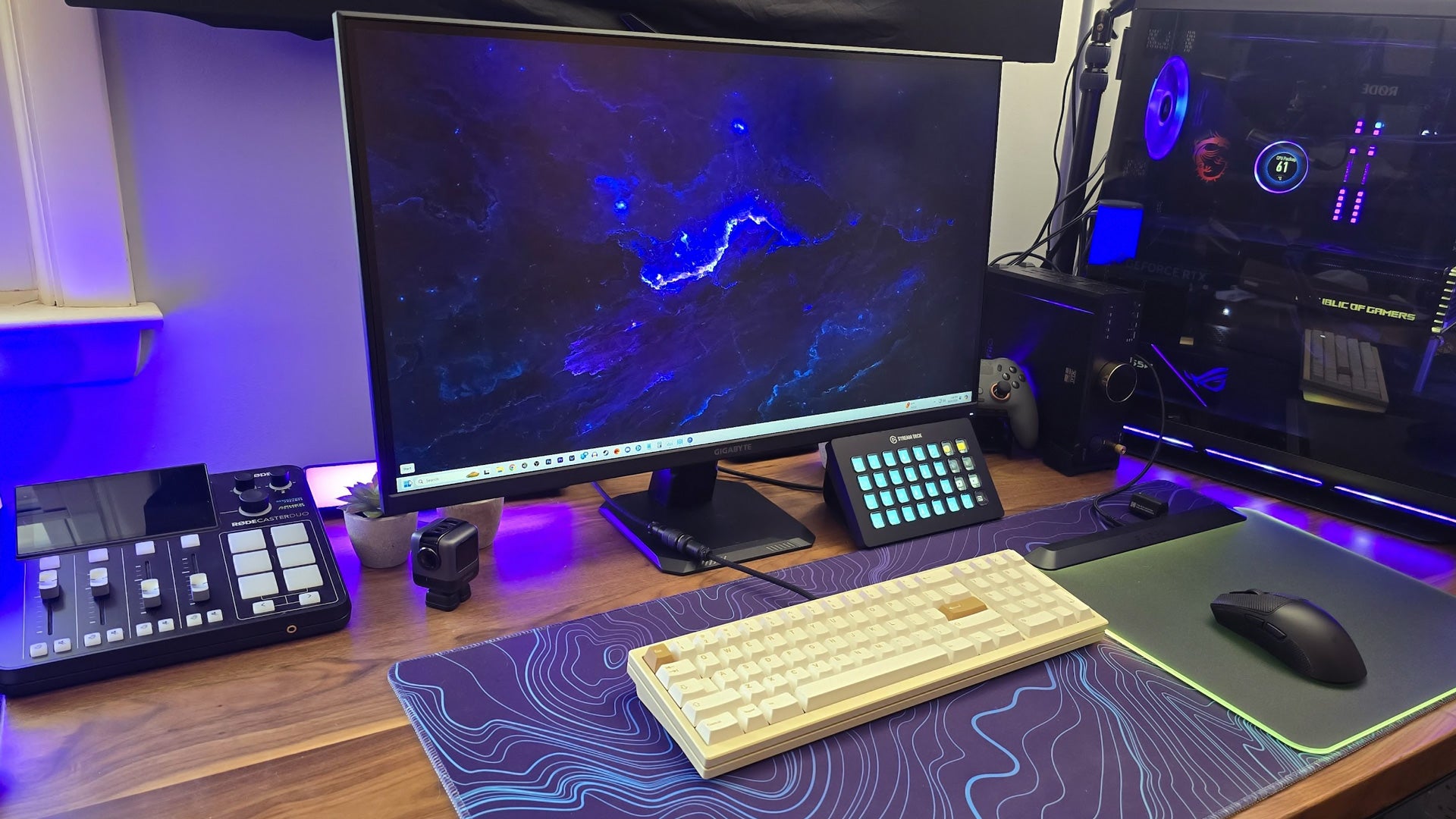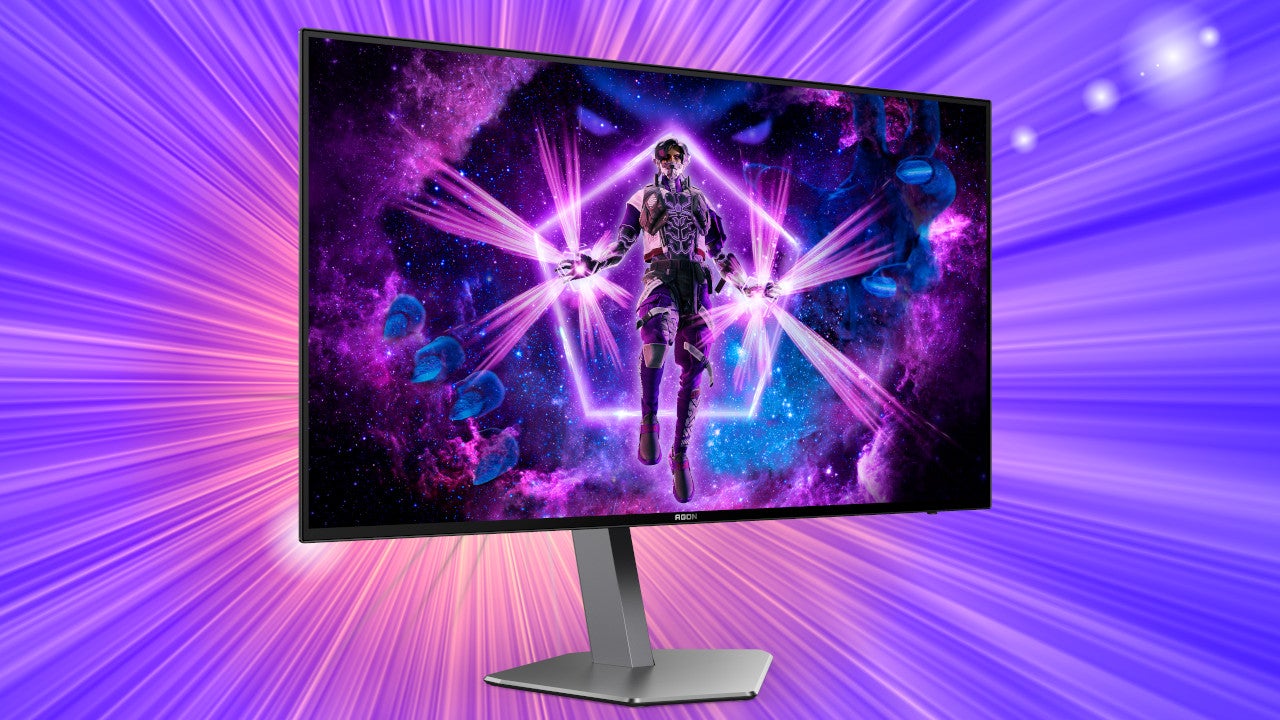With all the hype surrounding fancy OLED gaming monitors this year, it can be easy to forget just how much the affordable gaming monitor market has also expanded. Gigabyte has been one of the key players in both spaces, offering its premium Aorus monitors on the higher-end of the pricing and feature spectrum, and its self-branded monitors with lower prices and competitive features. The Gigabyte GS27Q falls into the latter camp, but while it’s able to offer a good picture and gaming experience, its terrible stand, poor picture quality out of the box, and similarity to other, better Gigabyte monitors makes us wonder why it even exists.
Gigabyte GS27Q – Design and Features
The GS27Q comes to market at $249.99 and offers a large, 27-inch IPS screen with SuperSpeed technology for a fast 1ms response time. It’s the beneficiary of gaming features trickling down from the Aorus line, like Aim Stabilizer, which strobes the backlight to reduce motion blur. It has a resolution of 2560x1440 (1440p) and a fast refresh rate of 165Hz that can be overclocked to 170Hz through the OSD or the OSD Sidekick Windows app. It also supports variable refresh rate with support for AMD FreeSync Premium and compatibility with Nvidia G-Sync.
Like most of Gigabyte’s non-Aorus monitors, it’s simply designed. There’s very little that indicates it’s a gaming monitor at all except for the word “gaming” stamped on the base of its stand and on the rear cable management bracket. It’s thin and looks modern in that way, though at the end of the day, it’s a basic design that really doesn’t attract any attention, for better or worse.

The bezels are slim, which usually maximizes screen space. Here, there’s a sizeable black border around the actual display that undermines this. This type of outlining isn’t uncommon but it definitely stands out and feels more pronounced here, like maybe it’s a bit more cut-in than other IPS gaming monitors. It could also just be a knock-on effect from the bad impression given by its stand.
The stand is genuinely one of the worst I’ve ever used. It offers a modicum of adjustability with -5 to +20 degrees of tilt adjustment but that’s it. A lack of height adjustment isn’t unusual in this price range, but very few sit as low as the GS27Q does. It’s as if you took a better stand and pushed it all the way to the bottom and locked it there. It does support standard VESA mounting if you choose to swap it out for something better, which I would recommend you do.

Connectivity is also limited to just the basics. It offers two HDMI 2.0 ports and a single DisplayPort 1.4 connection for video inputs. There’s also a headphone jack as the monitor lacks any kind of speakers. There’s no USB hub or KVM like you’ll find on Gigabyte’s cheaper M27Q, the upgraded version of which is one of our picks for the best 240Hz gaming monitor of the year so far.
It’s clear that Gigabyte pared this monitor back to the basics to keep its price low, but its core features are unmistakably appealing. 27-inches is a sweet spot for 1440p, balancing a large screen with a crisp picture. It has a pixel density of 109 pixels per inch, so in-game visuals and pictures are all clear. Oddly, I found text to be a bit fuzzy out of the box, but I was able to clear it up using Windows ClearType.
IPS panels are frequently recommended due to their increased color vibrancy and the GS27Q is no exception. Gigabyte rates the monitor as covering 100% of the SRGB color space, which was true in my testing. It also covered 82% of the DCI-P3 color space, and is reasonably bright at 306-nits (measured), which is slightly higher than the rated 300-nits.

Controlling the monitor is done using a joystick positioned below the center of the screen. It works well enough, certainly better than the old school buttons found on office monitors. You can avoid using it entirely through Gigabyte’s OSD Sidekick software which allows you to configure all of its settings with your mouse.
Gigabyte GS27Q – OSD and Gaming Features
The OSD for the monitor is split into the usual categories of Gaming, Picture, Display, System, and so on. To its credit, Gigabyte provides plentiful options for tuning the picture, including brightness, contrast, color vibrance, temperature, gamma, and sharpness settings, as well as add-ons like dynamic contrast and a low blue light mode. There are also the usual presets for different genres and content types. The default settings are not good, which I’ll discuss more in the performance section. But, suffice it to say, you’ll need to plan on tweaking the picture if you want anything resembling what this monitor is capable of.
Gaming features are more limited than I expected. There are essentially three options dedicated to gaming: Aim Stabilizer, Black Equalizer, and Super Resolution, not including basic options like overdrive and VRR. Aim Stabilizer strobes the backlight to reduce motion blur but does so at the expense of brightness. Black Equalizer raises the shadows allowing you to spot enemies more easily in the dark. And Super Resolution helps scale up lower-resolution content so it looks better on the GS27Q’s larger screen.
All of these options are also available using Gigabyte’s OSD Sidekick application, which is more convenient to use than the OSD itself. Hotkeys have been removed for some reason, which is a bit of a shame because it makes using features like Black Equalizer harder to access in the middle of competitive matches. It’s not a feature you want to leave on all the time, so it’s disappointing to see features being removed from the software instead of added.
Gigabyte GS27Q – Performance
Turning it on for the first time, the GS27Q surprised me – and not in a good way. The picture was extremely washed out, worse than any IPS monitor I’ve ever used. I’ve tested many Gigabyte monitors and have never experienced such poor image quality out of the box. It was bad enough that I considered reaching out to my contact at the company to see if it might be defective.
But it wasn’t a problem with the panel, it was with the settings. As I explored the menus trying to find a reason for the bland picture, it was Black Equalizer. It comes out of the box set to ten, its midway point, but that’s far too high for any kind of decent picture. This setting is designed to raise the shadows in games, lightening up dark tones. Outside of this purpose, it’s image-destroying, turning anything on the screen into a bland wash. It took dropping this setting three whole steps to correct the black levels. I also had to turn up the actual contrast setting because, even at full brightness the screen remained dull on default settings. It’s possible to make the screen look good, but you’ll need to put in the work to get there.

Given all of this, I wasn’t surprised to find that the out of box calibration was also off the mark. A calibration run with my SpyderX Elite colorimeter fixed it up, but even that is fraught. If you were to run a calibration cycle with the Black Equalizer left to its default, the colorimeter has to work extra hard and the resulting picture is still disappointing. To calibrate it properly, you first need to turn down this gaming setting and then work on the colors.
How it made it out of the factory looking so bad is shocking. Had I purchased this monitor and not thought to lower this setting – which is technically a gaming feature and not even a picture setting – I would have been looking for something that actually looked like a $250 IPS. Based on the user reviews, I’m not sure if it was just my sample that was configured this way or if people just aren’t commenting on it, but it’s something any potential customer should be prepared for.
With that corrected, the picture can actually look very good and provide a good gaming experience. The short stand was perpetually distracting, however, and forced me to put a box underneath it to get it to a usable height. On its own, it leaves the screen uncomfortably low. I raised my sit-stand desk until it was at a proper height but then my keyboard and mouse were too high. The stand needs to go back to the drawing board because it’s just plain bad. The monitor necessitates a riser or third-party arm, in my opinion.
When it’s properly configured and raised to a proper height, its strengths finally begin to show. Its SuperSpeed panel eliminated visible ghosting in every game I played. Some was still visible in the BlurBusters Ghosting Test, which is expected with any IPS gaming monitor, but it didn’t translate through to anything I could see with the naked eye in actual games.

The color rendition is also very good. I prefer saturated colors, so tweaking the color vibrancy up a notch also enhanced the experience. I tried to use the sharpening feature but one step up introduced artifacts and one step down introduced text blur, so it was out. Focusing just on core picture settings, the panel actually wound up being quite nice for gaming.
With it dialed in, it becomes a very competent gaming monitor. I didn’t experience any artifacts or weirdness running the monitor in its overclocked 170Hz mode. The lower native contrast of IPS (rated at 1000:1) did make blacks in indoor areas of Battlefield 2042 and the sewers of Baldur’s Gate look more grey, but my unit didn’t suffer from abnormal backlight bleed near the edge lights.
The monitor is fine overall, nothing too special and nothing so terrible it can’t be worked around, but it finds itself in a strange place. It exists alongside Gigabyte’s other 27-inch SuperSpeed IPS gaming monitor, the M27Q. On paper, these monitors are very similar, except the M27Q is brighter, has an even faster 0.5ms response time, includes a USB hub and built-in KVM, a height adjustable stand, and has been out long enough to be confident that it has a good picture right out of the box, all for $229. For the extra $20, the GS27Q gives you a smaller base to save a few inches of desk space and a lot more work to get it looking good.
Even if the prices were reversed, the M27Q would still be the better buy. Given the similarities in their panels, their feature set, and gaming prowess, it’s just not clear why the GS27Q even exists.







